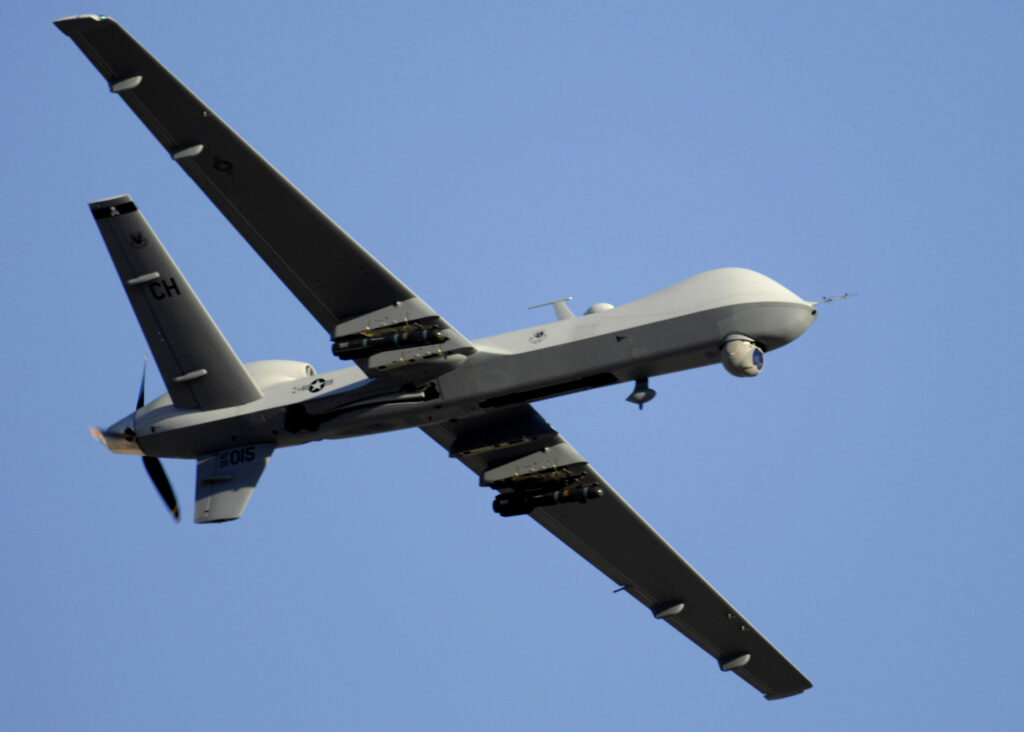An USAF MQ-9 “Reaper” unmanned aerial vehicle (UAV) operated by the 89th Attack Squadron, Ellsworth Air Force Base, SD, conducted Operation Jackpot Hooligan III during Operation Neptune Strike 23.1, February 23, 2023. During the event, the UAV integrated with air and naval forces to execute a simulated long-range missile strike on a simulated adversarial ship.
“The cutting-edge capabilities provided by the MQ-9 allowed airmen on the other side of the world to have a positive, direct impact on combat operations in the middle of the Ionian Sea, giving Naval Strike and Support Forces NATO the ability to make decisions in real-time and to deliver decisive combat victories,” said CAPT. Alex Hampton, commander, Carrier Air Wing (CVW) 7. “This is one example of what the MQ-9 can do for the U.S. Navy to continuously increase NATO’s military capabilities across all warfighting domains.”

NATO Air Command, comprised of airmen from France and Great Britain, located the ship in the southern Ionian Sea using long-range synthetic-aperture radar. The team used the information to create a realistic combat scenario and provided the information to the MQ-9.
The MQ-9 passed the target ship’s coordinates to an E-2D Hawkeye, attached to Carrier Airborne Command and Control Squadron (VAW) 121, who then passed the information to a strike force comprised of F/A-18s, attached to CVW-7, and Spanish AV-8B Harriers.
The E-2D successfully vectored the strike force to an area safe from simulated enemy air defenses. The strike force then began its’ attack utilizing the intelligence provided by the UAV.
“Having the MQ-9 involved in Operation Neptune Strike was a great opportunity to train with our NATO partners, which we rarely get to do,” said Maj. Matt Mraz, MQ-9 liaison officer, embarked aboard the Nimitz-class aircraft carrier USS George H.W. Bush (CVN 77). “Since partnering with Carrier Strike Group (CSG) 10 six months ago, we’ve increased our combined lethality while decreasing the time needed to work through our standard kill chain process. This strike exercise is the first of many great things for U.S. Air Force and U.S. Navy integration.”
Throughout the attack run, the MQ-9 maintained positive identification of the enemy ship and conducted scans around it to ensure the strike force’s weapons would only target the chosen vessel, eliminating collateral damage to civilian ships in the area.
The strike force launched the simulated munitions and maneuvered to remain outside the enemy’s simulated air defenses, effectively denying the enemy a chance to target friendly aircraft.
After the strike, the UAV employed its powerful full-motion video camera to complete a post-attack assessment of the strike, relayed the data to Strike Force NATO, and passed vital information to countries across the alliance via radio, chat, and Link-16.
This exercise was the third iteration of Jackpot Hooligan. Jackpot Hooligan I was a synthetic training exercise wherein personnel from across the strike group, partner branches, and multiple warfare commanders within the strike group integrated to increase their capability while limiting risk to personnel and assets. Jackpot Hooligan II was a first-of-its-kind maritime strike exercise that demonstrated the ability of the MQ-9 to integrate with naval forces to eliminate a target in an anti-surface warfare mission.
The experience gained from the recurring integration of the units of CSG-10 and the MQ-9 community enabled smooth integration during exercise Jackpot Hooligan III. It opened the door for more successful interoperability in the future.
(via https://www.dvidshub.net)













Leave a comment